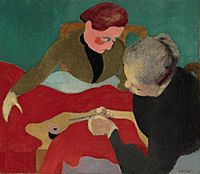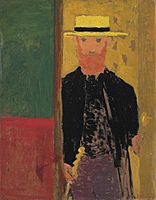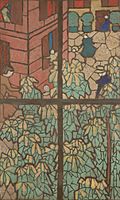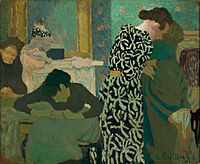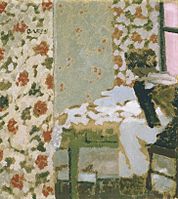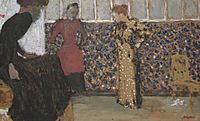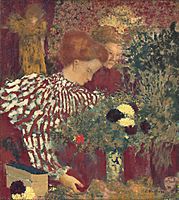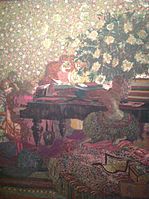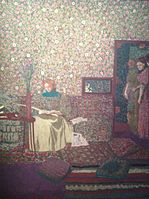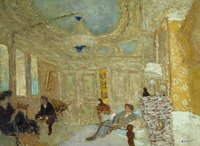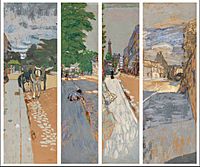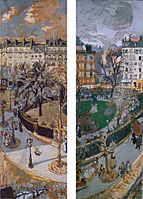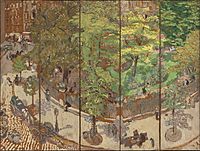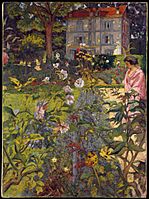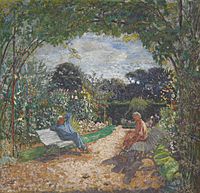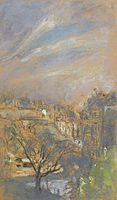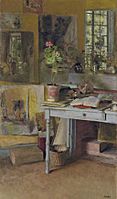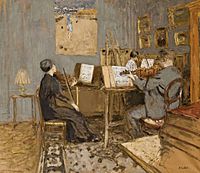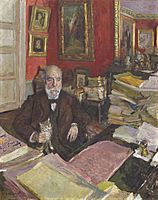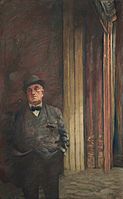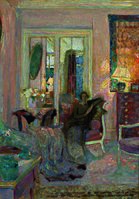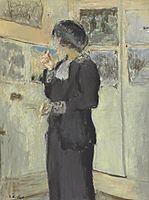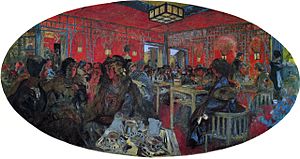Édouard Vuillard facts for kids
Quick facts for kids
Édouard Vuillard
|
|
|---|---|

Self-portrait, 1889, oil on canvas
|
|
| Born | 11 November 1868 Cuiseaux, Saône-et-Loire, France
|
| Died | 21 June 1940 (aged 71) La Baule, Loire-Inférieure, France
|
| Known for | Painting, printmaking |
Jean-Édouard Vuillard (French: [vɥijaʁ]; 11 November 1868 – 21 June 1940) was a French painter and printmaker. He was also known for his decorative art. From 1891 to 1900, Vuillard was an important member of an art group called Les Nabis. This group created paintings using areas of pure color. His indoor scenes were inspired by Japanese prints. They showed how flat areas of color, patterns, and shapes could create interesting spaces. Vuillard also designed theater sets, wall panels, plates, and stained glass.
After 1900, when Les Nabis group broke up, Vuillard started painting in a more realistic style. He used more detail and brighter colors in his landscapes and indoor scenes. In the 1920s and 1930s, he painted portraits of famous French people in their own homes or workplaces. Vuillard was influenced by Paul Gauguin and other artists of his time.
Contents
Early Life
Jean-Édouard Vuillard was born on November 11, 1868, in Cuiseaux, France. He spent his childhood there. His father was a retired navy captain who later became a tax collector. His mother, Marie Vuillard, was a seamstress.
In 1877, his family moved to Paris. Vuillard went to a school run by the Marist Brothers. He later received a scholarship to attend the Lycée Fontaine, which became the Lycée Condorcet. At the Lycée, he studied art and drew copies of works by Michelangelo. He also met several friends who would later join him in the Les Nabis art group. These friends included Ker-Xavier Roussel and Maurice Denis.
In 1885, Vuillard decided to become an artist instead of following his father's military career. He joined Roussel at the studio of painter Diogène Maillart. There, they learned the basics of painting. Vuillard also took classes at the Académie Julian. He tried several times to get into the famous École des Beaux-Arts and was finally accepted in July 1887. He continued his art studies there until 1889.
Les Nabis Art Group
In late 1889, Vuillard started going to meetings of an art group called Les Nabis. This name means "The Prophets." It was a somewhat secret group that included Maurice Denis and other friends from the Lycée. In 1888, a young painter named Paul Sérusier had created a painting called The Talisman. This painting was almost abstract and used areas of color. It became the first Nabi painting.
Sérusier, Pierre Bonnard, Maurice Denis, and Paul Ranson were among the first Nabis. They wanted to change art completely. In 1890, Vuillard joined the group. They met in Ranson's studio or in cafes. The group was secret, and members used nicknames. Vuillard's nickname was Nabi Zouave because he had served in the military.
Vuillard first worked on designing sets for plays. He shared a studio with Bonnard and a theater director named Lugné-Poe. Vuillard designed sets for plays by Maeterlinck and other writers. In 1891, he showed his paintings for the first time with the Nabis. Critics generally liked his work, though some noted that his style was still developing.
Vuillard started keeping a journal around this time. In it, he wrote about his ideas on art. He believed that colors and shapes only make sense when they are seen together. He also wrote that a painting should be seen as a group of relationships, not just a copy of nature.
Japanese Influence
Vuillard and the Nabis were greatly influenced by Japanese woodblock prints. These prints were shown in Paris art galleries. Vuillard himself collected 180 Japanese prints. You can even see some of them in the backgrounds of his paintings.
The Japanese influence meant that his art often looked flat, without much depth. It also featured simple shapes and strong, contrasting colors. Faces in his paintings were often turned away or drawn with just a few lines. He did not try to create a realistic sense of distance. Patterns from wallpaper or clothes were often more important than the faces of the people. Sometimes, the people in his paintings almost disappeared into the designs around them.
Decorative Art
Vuillard, like other Nabis artists, believed that decorative art was just as important as traditional paintings. He created theater sets and programs, large wall murals, painted screens, and designs for stained glass windows and ceramic plates. In the early 1890s, he often worked for the Théâtre de l'Œuvre.
Vuillard soon started decorating homes. He met brothers Alexandre and Thadée Natanson, who started a cultural magazine called La Revue Blanche. Vuillard's art appeared in their magazine. In 1892, the Natanson brothers asked Vuillard to paint decorations for a house. He made more decorations for them in later years.
Vuillard used a painting method called peinture à la colle, or distemper. This method allowed him to paint large panels quickly. It involved using a special glue mixed with chalk and white paint. This created a smooth surface on wood panels or canvas. This technique helped him add fine details and rich colors.
In 1894, Vuillard and other Nabis artists designed stained glass windows for an art gallery owner named Siegfried Bing. Their designs were shown in 1895, but the windows were never actually made. In 1895, Vuillard also designed a series of decorative porcelain plates. These plates showed women in modern clothes, surrounded by floral designs.
The Public Gardens
Some of Vuillard's most famous works are Les Jardins Publiques (The Public Gardens) and Figures dans un Interieur (Figures in an Interior). He made these for the Natanson brothers and their friends. Between 1892 and 1899, Vuillard created eight sets of decorative paintings, with about thirty panels in total. These murals were not often shown during his lifetime, but they later became very famous.
The Public Gardens is a series of six panels that show children in the parks of Paris. The Natansons had three young daughters, which inspired the theme. Vuillard used the peinture à la colle method for this series. This meant he had to work very fast, but it also allowed him to make changes and create a fresco-like look. He finished the series in late 1894, and they were placed in the Natansons' dining room.
Interior Scenes
Vuillard often painted indoor scenes. These usually showed women at work, at home, or in a garden. The faces of the people in these paintings are rarely shown in great detail. Instead, Vuillard often focused more on the patterns of wallpaper, carpets, and furniture.
In his journal, Vuillard wrote that a very exact subject in a decorated room could become boring. He preferred to fill his indoor scenes with women. He felt that women offered more interesting elements for him as a painter.
Vuillard painted a series of scenes showing seamstresses in a workshop. These were based on his mother's sewing workshop. In La Robe à Ramages (The Flowered Dress; 1891), the women are made up of areas of color. Their faces are seen from the side and have no details. The patterns of their clothes and the room's decor are the main focus. He also used a mirror in the painting to show two views at once and to make the scene look flattened and decorative.
Seamstress with Chiffons (1893) also shows a seamstress working by a window. Her face is unclear, and the image looks almost flat. The floral patterns on the wall are very strong.
In 1895, Vuillard was asked to create four panels for a doctor's library in Paris. These paintings showed women playing piano, sewing, and doing other quiet activities in a fancy apartment. The one man in the series is shown reading, not paying much attention to the woman sewing next to him. The people in these panels almost blend into the detailed wallpaper, carpet, and dress patterns. Art critics compared these works to medieval tapestries. The paintings are now in the Petit Palais museum in Paris.
In 1897, Vuillard's indoor scenes started to change. His painting Large Interior with Six Persons was much more complex. It had more depth and color, and the people were more recognizable. The painting showed the apartment of Nabi painter Paul Ranson.
After Les Nabis (1900–1914)
The Nabis group went their separate ways after their exhibition in 1900. They had always had different styles, even though they shared similar ideas about art. After the group broke up, Vuillard's art style and subjects changed. He slowly stopped painting the dark, crowded indoor scenes he had done before 1900. He began to paint more outdoors, using natural light.
He still painted indoor scenes, but these were brighter and more colorful. They also had more depth, and the faces of people were clearer. The way light played in his paintings became very important. Vuillard slowly returned to a more naturalistic style. In November 1908, he had another big exhibition where he showed many of his new landscapes.
In 1912, Vuillard, Bonnard, and Roussel were offered the Légion d'honneur, a high French award. All three of them turned it down. Vuillard said he only wanted the respect of people who appreciated art.
Also in 1912, Vuillard painted Théodore Duret in his Study. This was a commissioned portrait that marked a new period in his work. From 1920 onwards, portrait painting became a major part of his art.
New Interiors, Cityscapes, and Gardens
After 1900, Vuillard continued to paint many homes and gardens. However, he used a more natural and colorful style than he had as a Nabi. Even though the faces of the people were often still turned away, his indoor scenes had depth, rich details, and warmer colors. He was especially good at capturing how sunlight played on gardens and his subjects. He wanted to move forward with a style that was more decorative, natural, and familiar.
He created new sets of decorative panels showing city scenes and parks in Paris. He also painted many indoor scenes of Paris shops and homes. He painted the galleries of the Louvre Museum and the Museum of Decorative Arts.
In 1909, he made sketches for decorative panels for a playwright named Henry Bernstein. These showed Place Vintimille in Paris, as seen from Vuillard's apartment. Like Claude Monet, he painted the same place in different seasons and weather. The panels of Place Vintimille still showed the Japanese influence in his art. This could be seen in the screen format, the bird's-eye view, and the simple shapes.
-
The Salle Clarac at the Louvre (1922)
Theater
Theater was a very important part of Vuillard's life. He started his art career by making sets for plays. He always stayed in touch with people in the theater world. Vuillard painted his friend, the actor and director Sacha Guitry.
In May 1912, Vuillard received a big request to paint seven panels for the new Théâtre des Champs-Élysées in Paris. These included a painting of Guitry in his theater box. He also went to performances by the Ballets Russes and dined with famous people like Sergei Diaghilev. In 1937, he and Bonnard created a large mural called La Comédie. It showed the history of Paris theater for the new Théâtre national de Chaillot.
Final Years (1914–1940)
When World War I started in August 1914, Vuillard briefly served in the military as a highway guard. He was soon released and went back to painting. He visited a factory owned by his friend Thadée Natanson and later painted three scenes of the factories. He also worked briefly as an official artist for the French army, making sketches of soldiers.
In 1921, Vuillard received an important request for decorative panels for an art collector in Switzerland. He completed four panels and two over-the-door paintings by 1922. From 1917 to 1924, he spent his summers in Vaucresson with his mother. He also painted many landscapes of that area.
Portraits
After 1920, Vuillard spent more and more time painting portraits for wealthy and important Parisians. He often used the peinture à la colle sur toile technique. This allowed him to create very precise details and rich colors. He painted people like the actor Sacha Guitry and the fashion designer Jeanne Lanvin.
He usually showed his subjects in their studios or homes. The backgrounds were very detailed, with lavish wallpaper, furniture, and carpets. These backgrounds helped create a mood and told a story. They also made the main person in the portrait stand out.
-
Portrait of Sacha Guitry (1925)
-
Jeanne Lanvin (1933)
Recognition and Death
From 1930 to 1935, Vuillard spent his time between Paris and a friend's home called Château de Clayes. He did not receive official recognition from the French government until July 1936. At that time, he was asked to create a mural called La Comédie. This mural showed his ideas about the history of Paris theater. It was for the new Théâtre national de Chaillot. In August 1936, the city of Paris bought four of his paintings. In 1937, Vuillard received another major request for a large mural at the League of Nations building in Geneva.
In 1938, Vuillard was elected to the Académie des Beaux Arts. In July, a major exhibition of his paintings was held. Later that year, he went to Geneva to oversee the installation of his mural Peace, Protector of the Arts.
Vuillard completed his last two portraits in 1940. He had lung problems and traveled to La Baule to get better. He died there on June 21, 1940. This was the same month that the French army was defeated by the Germans in World War II.
Personal Life
Vuillard never married. However, his personal life and his art were greatly influenced by his women friends. In the late 1890s, he became close with Misia Natanson, the wife of his important art supporter, Thadée Natanson. Misia appears in his Public Gardens paintings. He helped her decorate their apartment and often painted her.
In 1900, Vuillard met Lucy Hessel, the wife of an art dealer. She became his new inspiration. She traveled with him every year and gave him advice. She stayed with him until the end of his life.
Le Grand Teddy Painting Discovery
In 2014, a TV show called Fake or Fortune? looked into a painting owned by a British writer. He and the previous owners believed it was by Vuillard. The oval painting showed a café scene. It was thought to be one of three paintings Vuillard was asked to create in 1918. These paintings were meant to decorate a new Paris café called "Le Grand Teddy."
At the time, only one of these three paintings was known to still exist and be confirmed as a real Vuillard. With help from art experts, the TV show carefully investigated the painting. They also did a lot of research to find out where the painting had come from. After showing all the evidence to a committee in Paris, the painting was confirmed to be a genuine Vuillard.
Art Market
On November 13, 2017, Misia et Vallotton à Villeneuve became the most expensive Vuillard painting ever sold at auction. It sold for $17.75 million at Christie's.
Selected Exhibitions
- 1 July 2021 to 19 September 2021 – Private Lives: Home and Family in the Art of the Nabis, Paris 1889-1900, Cleveland Museum of Art, Cleveland, Ohio
- 13 March 2019 to 30 June 2019 – Les Nabis et le décor – Bonnard, Vuillard, Maurice Denis... Musée du Luxembourg, Paris
- 19 October 2018 – 20 January 2019 Maman Vuillard and Madame Vuillard, Barber Institute of Fine Arts in Birmingham
- 16 October 2015 – 15 February 2016 Indoor/Outdoor: Vuillard's "Landscapes and Interiors", Norton Simon Museum in Pasadena
- 4 May 2012 – 23 September 2012 Edouard Vuillard: A Painter and His Muses, 1890–1940 , The Jewish Museum in New York
- 19 January 2003 – 20 April 2003 Édouard Vuillard, National Gallery of Art in Washington, DC
- 25 September 2003 – 4 January 2004 Edouard Vuillard (1868–1940), Musée d'Orsay in Paris
Selected Works
- The Green Interior or Figure in front of a Window with Drawn Curtains (1891), Metropolitan Museum of Art
- Self Portrait (1892)
- Woman Sweeping (1892)
- Mother and Sister of the Artist (1893)
- The Seamstress (1893), Indianapolis Museum of Art
- The Yellow Curtain (1893)
- Married Life (1894)
- Under the Trees (from "The Public Gardens") (1894), Cleveland Museum of Art
- Chestnut Trees, a Cartoon for a Tiffany Stained-Glass Window (1894–95), Dallas Museum of Art
- At the Café (c.1897–1899), Cleveland Museum of Art
- Woman in Blue With Child (Misia Natanson with Mimi Godebska, rue Saint-Florentin) (1899)
- Interior: Madame Vuillard and Grand-Mère Roussel at L'Étang-la-Ville (1900–01), Dallas Museum of Art
- At the Revue Blanche (Portrait of Félix Fénéon), 1901, Guggenheim Museum
- Le Déjeuner à Villeneuve-sur-Yonne (1902)
- Café Wepler (1908–10, reworked in 1912), Cleveland Museum of Art
- Le Grand Teddy (1918)
- Garden at Vaucresson (1920, reworked in 1926, 1935, 1936), Metropolitan Museum of Art
- André Bénac (1936), Cleveland Museum of Art
See also
 In Spanish: Édouard Vuillard para niños
In Spanish: Édouard Vuillard para niños
- Intimism (art movement)
- Post-Impressionism



